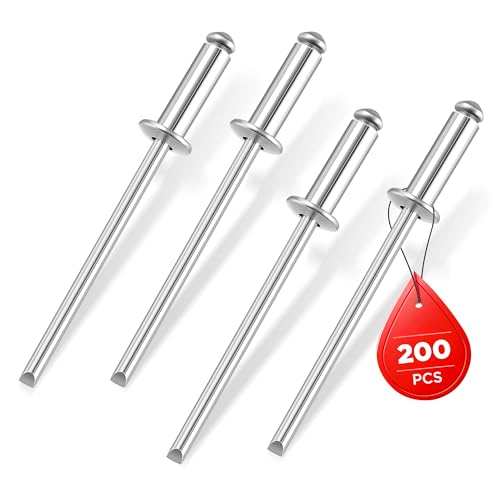Well, now that I have all the tools and materials to re-rivet our beloved tin boats projects, a friend brought me his to look it. His tin hull weighs 800-lbs by the book, without motor or gear and it was always stored on the trailer that has two 8’ long bunks to support the hull, one down each side. He’s been complaining of a water leak for years now, but this season it became too much, where he won’t trust going away for any length of time with the boat in the water, even though it has an operable automatic bilge pump.
Knowing it is a boat used in saltwater and that the bunks are carpeted, I asked him if he ever looked at the hull where the bunks are located? And of course the answer was ‘No’. She we carefully blocked off and then jacked up one side of the hull at time, lifting it a good 6” off the bunk and placed deadman supports in place so we could work under there without losing a finger or arm … careful – they’re attached!
Look at that corrosion damage! We cannot verify that the bunks were made out of pressure treated wood (20-year old trailer), but it definitely is a saltwater boat and the area where the boat sits on the bunks has never been painted. He would scrape the bottom while it in the water once or twice per season, using a mask and snorkel, but he never looked close at the tin surface. I think it is indicative of crevice corrosion, as aluminum protects itself by the oxide layer of oxygen present in the atmosphere. Stainless steels too are very prone to crevice corrosion … cut off some part of the material to “free air” and it will corrode.
Most surprisingly the pin hole or crevice damage as shown was confined to the 1st foot of the bunk on each side, forward towards the bow end, with barely any – if any – signs of corrosive damage on the rest of the bunk length. I think this is caused by the sheer weight of the hull, being a 16’ hull only supported for 8’ of its length, where the bunks stop about 6” from the stern. This supports the contention that it is most likely caused by crevice corrosion. As even though the stern holds the 250-lb motor, the complete forward part of the boat is probably all borne the 1st foot of each bunk up the front, completely squeezing the carpet and shutting out any free air. Then too, that carpet was soaked in saltwater 2X per season – hopefully just once in and once out, LOL.
Our plan of attack is to scrape and sand the bunk areas – then vinegar wash them (working in one direction only) with a copper scrubby pad and then coarse wet paper – wipe down (1 direction only) w/ vinegar-soaked clean rag – air dry – spray with etching zinc chromate primer – sealing with G-Flex flexible epoxy – and finally adding a copper-free ablative bottom paint to these areas.
Whaddya think?
I will say that any rivets in the surrounding area, and even the chine areas, and all over rest of the bottom of the hull look in an amazingly great condition for an otherwise old hull!
Knowing it is a boat used in saltwater and that the bunks are carpeted, I asked him if he ever looked at the hull where the bunks are located? And of course the answer was ‘No’. She we carefully blocked off and then jacked up one side of the hull at time, lifting it a good 6” off the bunk and placed deadman supports in place so we could work under there without losing a finger or arm … careful – they’re attached!
Look at that corrosion damage! We cannot verify that the bunks were made out of pressure treated wood (20-year old trailer), but it definitely is a saltwater boat and the area where the boat sits on the bunks has never been painted. He would scrape the bottom while it in the water once or twice per season, using a mask and snorkel, but he never looked close at the tin surface. I think it is indicative of crevice corrosion, as aluminum protects itself by the oxide layer of oxygen present in the atmosphere. Stainless steels too are very prone to crevice corrosion … cut off some part of the material to “free air” and it will corrode.
Most surprisingly the pin hole or crevice damage as shown was confined to the 1st foot of the bunk on each side, forward towards the bow end, with barely any – if any – signs of corrosive damage on the rest of the bunk length. I think this is caused by the sheer weight of the hull, being a 16’ hull only supported for 8’ of its length, where the bunks stop about 6” from the stern. This supports the contention that it is most likely caused by crevice corrosion. As even though the stern holds the 250-lb motor, the complete forward part of the boat is probably all borne the 1st foot of each bunk up the front, completely squeezing the carpet and shutting out any free air. Then too, that carpet was soaked in saltwater 2X per season – hopefully just once in and once out, LOL.
Our plan of attack is to scrape and sand the bunk areas – then vinegar wash them (working in one direction only) with a copper scrubby pad and then coarse wet paper – wipe down (1 direction only) w/ vinegar-soaked clean rag – air dry – spray with etching zinc chromate primer – sealing with G-Flex flexible epoxy – and finally adding a copper-free ablative bottom paint to these areas.
Whaddya think?
I will say that any rivets in the surrounding area, and even the chine areas, and all over rest of the bottom of the hull look in an amazingly great condition for an otherwise old hull!

























































